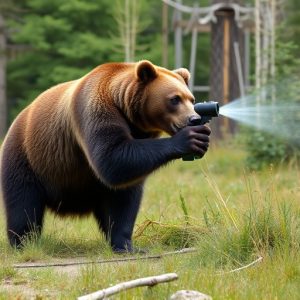Navigating Alaska’s Bear Spray Regulations: Protecting Wildlife Through Responsible Use
Bear spray residue, a byproduct of self-defense against bears, poses significant ecological risks. M…….
Bear spray residue, a byproduct of self-defense against bears, poses significant ecological risks. Microscopic particles can disrupt ecosystems, affecting not just targeted bears but also other wildlife. While effective for human safety, responsible usage and disposal are crucial to minimize the environmental impact of bear spray, balancing human protection with ecological preservation in Alaska's diverse wildlife ecosystem. Navigating state regulations on bear spray is vital for visitors and residents alike to ensure proper use and protect unique ecosystems.
Alaska’s rugged terrain makes bear encounters a real possibility for outdoor enthusiasts. Understanding bear spray fogger defense is crucial, especially with the growing popularity of remote adventures. This article delves into the science behind bear spray residue and its environmental implications, explores the short-term and long-term effects on wildlife, and navigates Alaska’s regulations to ensure responsible usage, promoting safety without compromising the well-being of our wild neighbors.
- Understanding Bear Spray Residue: How It Works and Its Environmental Implications
- The Impact of Bear Spray on Wildlife: Short-term and Long-term Effects
- Navigating Alaska's Regulations: Using Bear Spray Responsibly to Protect Both You and Wildlife
Understanding Bear Spray Residue: How It Works and Its Environmental Implications
Bear spray residue, a byproduct of using bear spray for self-defense, is an essential aspect to consider when discussing wildlife impact. When bears are sprayed, the chemical agents create a fog or cloud that can leave behind microscopic particles known as residues. These residues remain in the environment, potentially affecting not only the targeted bear but also other wildlife and ecosystems.
Understanding how bear spray residue works is crucial. The active ingredients in bear spray temporarily disable a bear’s senses, making it an effective defense mechanism for humans encountering bears. However, these chemicals can persist in the environment, leading to potential ecological disruptions. Research suggests that residue may impact bear behavior, alter food sources, and even affect non-target species, highlighting the need for responsible usage and disposal of bear spray to minimize environmental implications.
The Impact of Bear Spray on Wildlife: Short-term and Long-term Effects
Bear spray, a common defense tool for outdoor enthusiasts in Alaska and other bear-inhabited regions, has both immediate and long-term effects on wildlife. When used correctly, it can deter aggressive bears, providing valuable time to escape or secure shelter. The active ingredients in bear spray temporarily disrupt a bear’s sensory perception, causing them to withdraw from the area. This is crucial for human safety, as it reduces the risk of serious injury or fatal encounters.
However, it’s essential to consider the broader impact on wildlife. Bear spray residue can remain on vegetation and surfaces for extended periods, potentially affecting non-target species that come into contact with it. Short-term effects on wildlife may include irritation, temporary blindness, or disorientation. Long-term exposure could lead to more severe consequences, such as endocrine disruption in bears and other animals, particularly if the spray contaminates water sources or food supplies. Therefore, responsible use and proper disposal of bear spray are vital to minimizing its impact on Alaska’s diverse wildlife ecosystem.
Navigating Alaska's Regulations: Using Bear Spray Responsibly to Protect Both You and Wildlife
Navigating Alaska’s regulations regarding bear spray is crucial for both visitors and residents aiming to protect themselves while also preserving wildlife. The state has specific guidelines on usage, emphasizing responsible handling to minimize the impact on local ecosystems. Bear spray residue can persist in the environment, affecting not just bears but other wildlife as well. Understanding these rules ensures that you use the spray appropriately, reducing potential harm to both people and animals.
When using bear spray, it’s essential to follow recommended practices. This includes knowing the proper distance to deploy the spray, understanding its range, and being mindful of wind direction to prevent unintended consequences. Responsible usage involves aiming for the bear’s face and eyes while keeping yourself at a safe distance. By adhering to these measures, you can protect yourself effectively without causing unnecessary disruption to Alaska’s wildlife and their habitats.
In understanding the complexities of bear spray residue and its environmental impact on wildlife, it’s clear that responsible usage is key. Balancing personal safety with preserving wildlife habitats requires a nuanced approach. By navigating Alaska’s regulations and using bear spray thoughtfully, individuals can protect themselves while mitigating long-term effects on local ecosystems. This dual focus ensures a harmonious coexistence between humans and wildlife in the unique Alaskan landscape.


